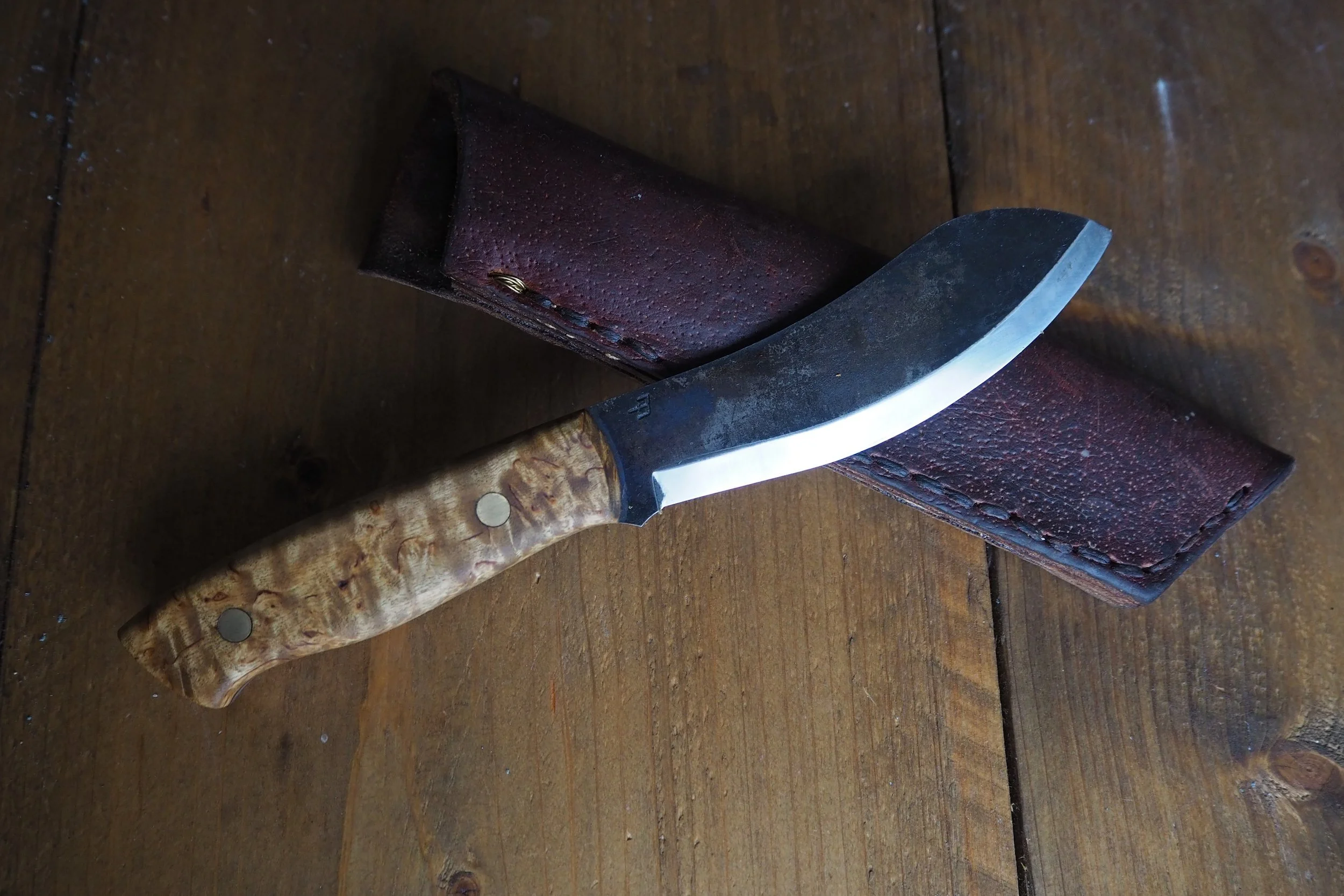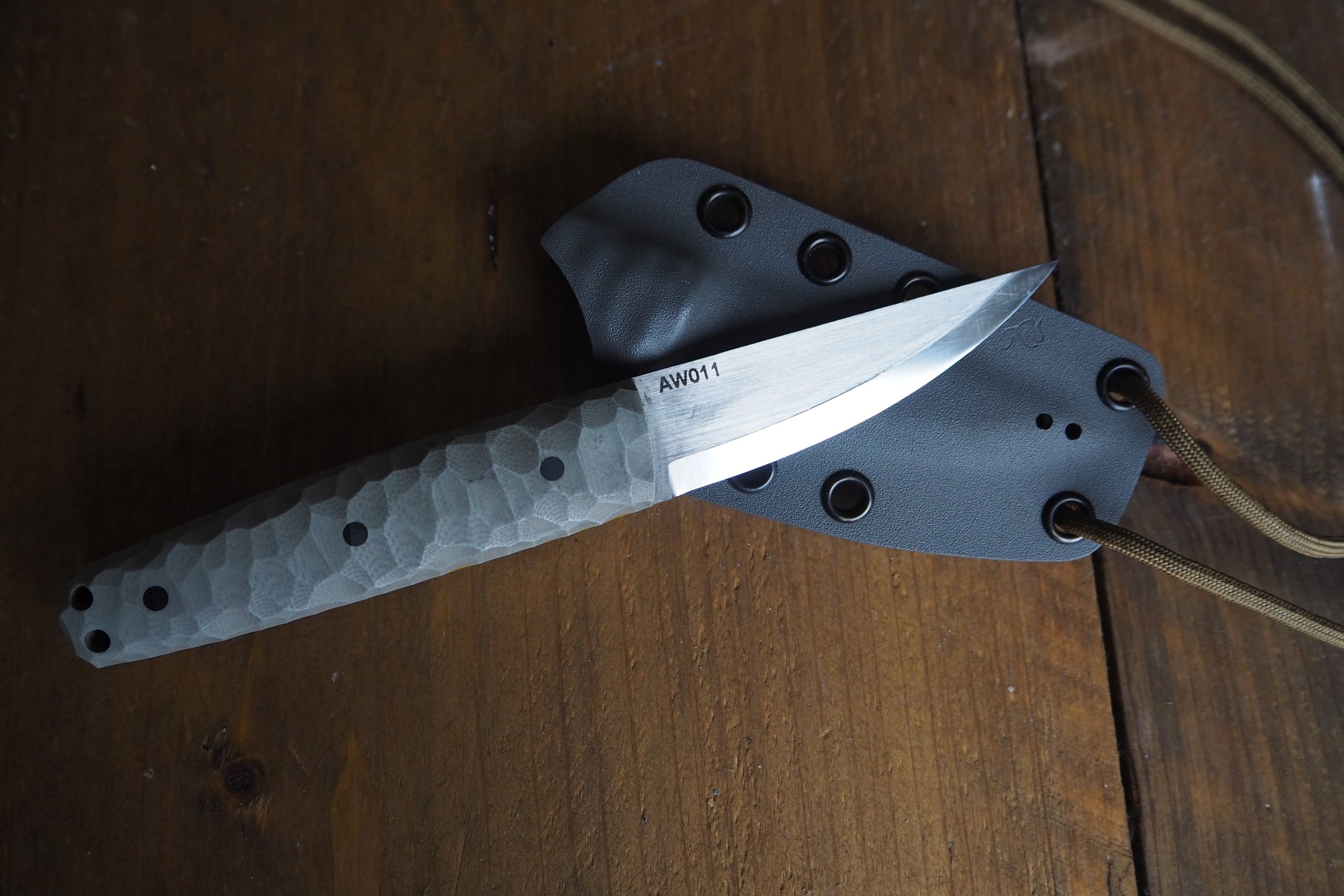My Personal Bushcraft Knives
Jamie Dakota
I shared a post last week on Instagram regarding the use of the Birch Polypore fungus to make a strop for honing knives; given the great feedback an interest I received there seemed to be an interest in the knives I’ve used over the years. So I thought I share a quick run down of my current collection, their virtues and short comings, and my general opinion of them.
Here we go with the knives I still have, not an exhaustive list of every knife I’ve ever owned but these are the ones that I kept….
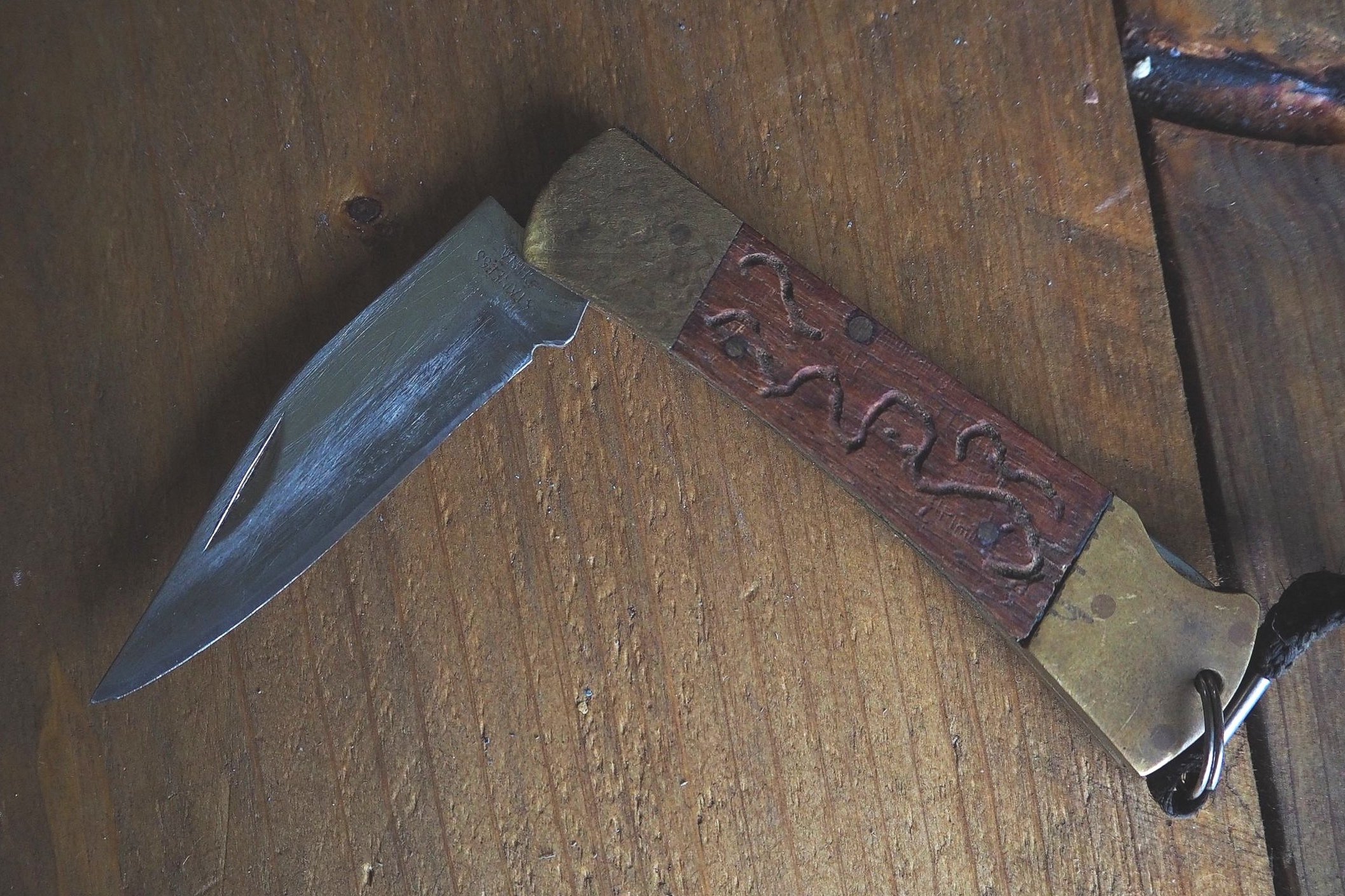
An early pocket knife
This is one of my earliest pocket knives, I got it from a seaside shop when I was about 10 years old. Although the blade shape is actually quite nice, this is quite honestly one of the worse knives I ever seen. The poor stainless steel and terrible build quality meant I never took an edge that didn’t immediately go blunt. The whole blade wobbles from the loose pin. On the plus side, the locking mechanism never failed me and the doodles I did in the wood with a Dremel drill have lasted well!
You can see from the blade that I used this knife extensively to learn how to sharpen (not surprising given it went blunt so fast). As a child I tried with an old grit stone my dad got from B and Q which I wasn’t very good at, so turned to sharpening it with a Dremel drill with various attachments to try and get it sharp. The slight hollow grind didn’t help, and I never did get it very sharp when I was young. Recently I thought it would be fun to try my hand at sharpening it given my experience since then… you can see the secondary bevel I’ve now given it. It passed the paper test… twice, then needed resharpening! haha
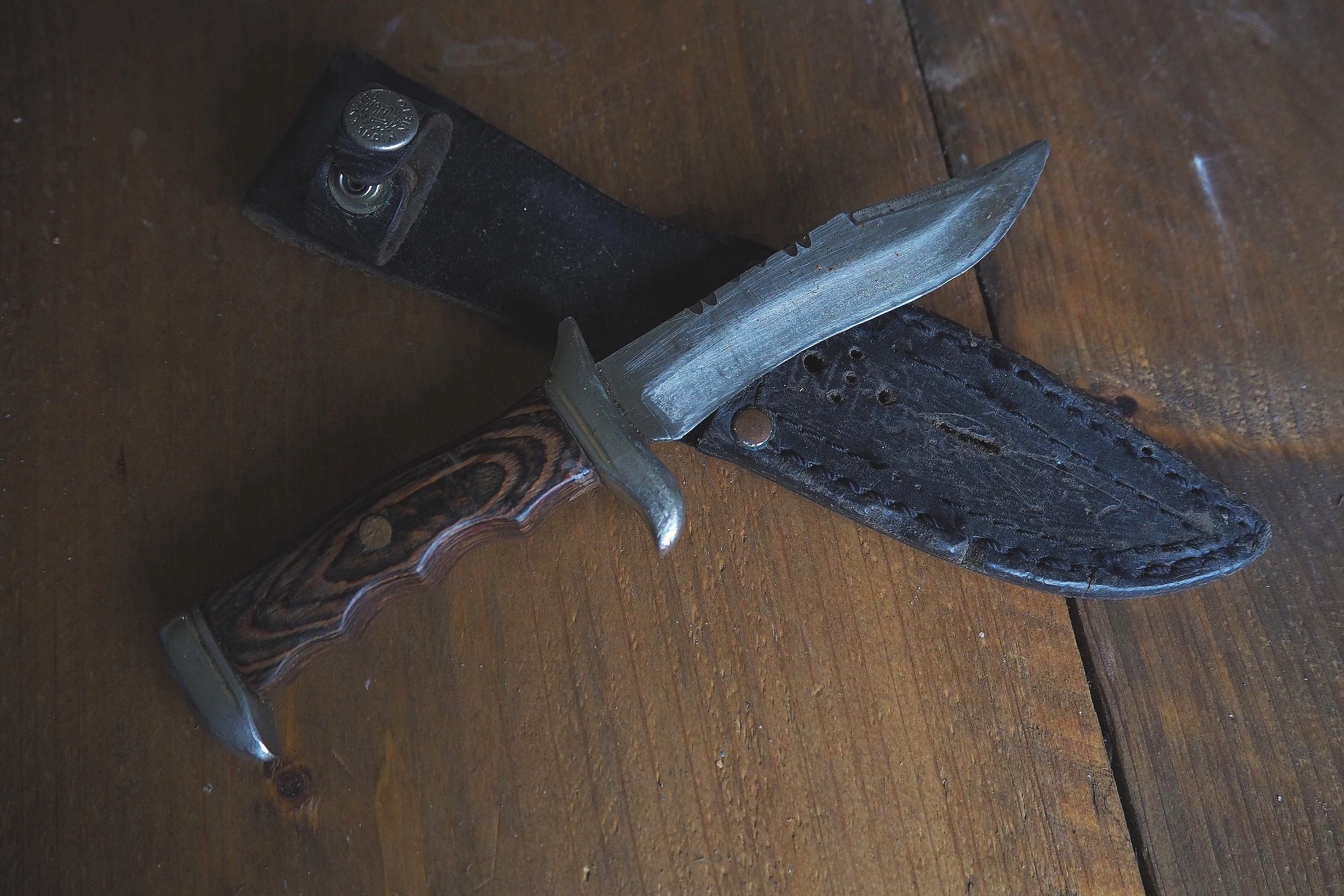
My first belt knife
I still have something of a soft spot for Winona, as I called her, as this really was my first belt knife and at the beginning of my journey into Bushcraft.
I got this one from a seaside shop at Skegness when I was 14. It’s stainless steel, I think possibly stick tanged though I’m not sure. The bolsters are plated with brass I think. The tip is missing because I used this knife as a pick to climb a huge fallen pine root bowl… ah to be 15 again.
As with my first pocket knife the steel wouldn’t take an edge, let alone hold one. And of course the blade shape doesn’t lend itself well to general green woodwork. The handle at the time fit my hand very well in a standard forehand grip, but as I grew it got too small. I had much the same trial and error with the stones and Dremel trying to sharpen this in my teens. This was the last knife I bought before getting Mears’ Outdoor Survival Handbook, which led to the change noted below.
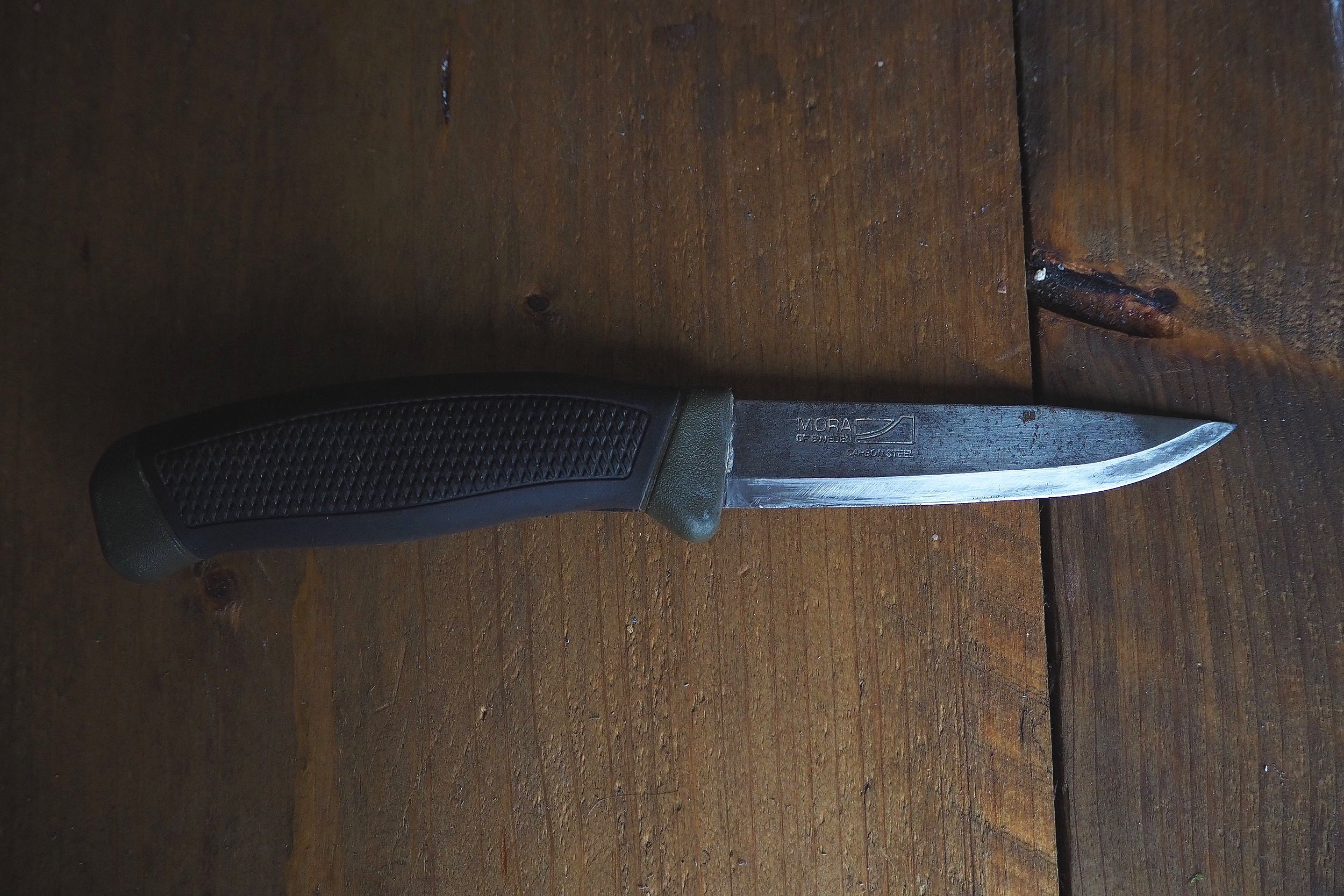
Mora Companion
Here we see the transition most people make at one time or another into the Scandi ground bevel type. This is one of my first mora knives, though I can’t be certain it’s my actual first.
The companion model is popular for good reason, the sensible size of blade and comfortable asymmetrical handle combined with the scandi ground, high quality carbon steel make it effective and easy to maintain. The perfect knife for the learner, and the reason we gift these to our Itinerant Bushcraft participants.

Mora Classic No1
I got this knife after reading Mors Kochanski’s Northern Bushcraft book. I liked the minimalist design and simple style. The handle is very comfortable but I found I didn’t trust it when I was in wet conditions. It is however excellent as a general utility knife, one I still enjoy using today. It’s been on many a hike and camping trip, I quite like spoon carving with it. I have, out of curiosity taken down saplings 20cm in diameter with it, but mostly I like it for finer work.
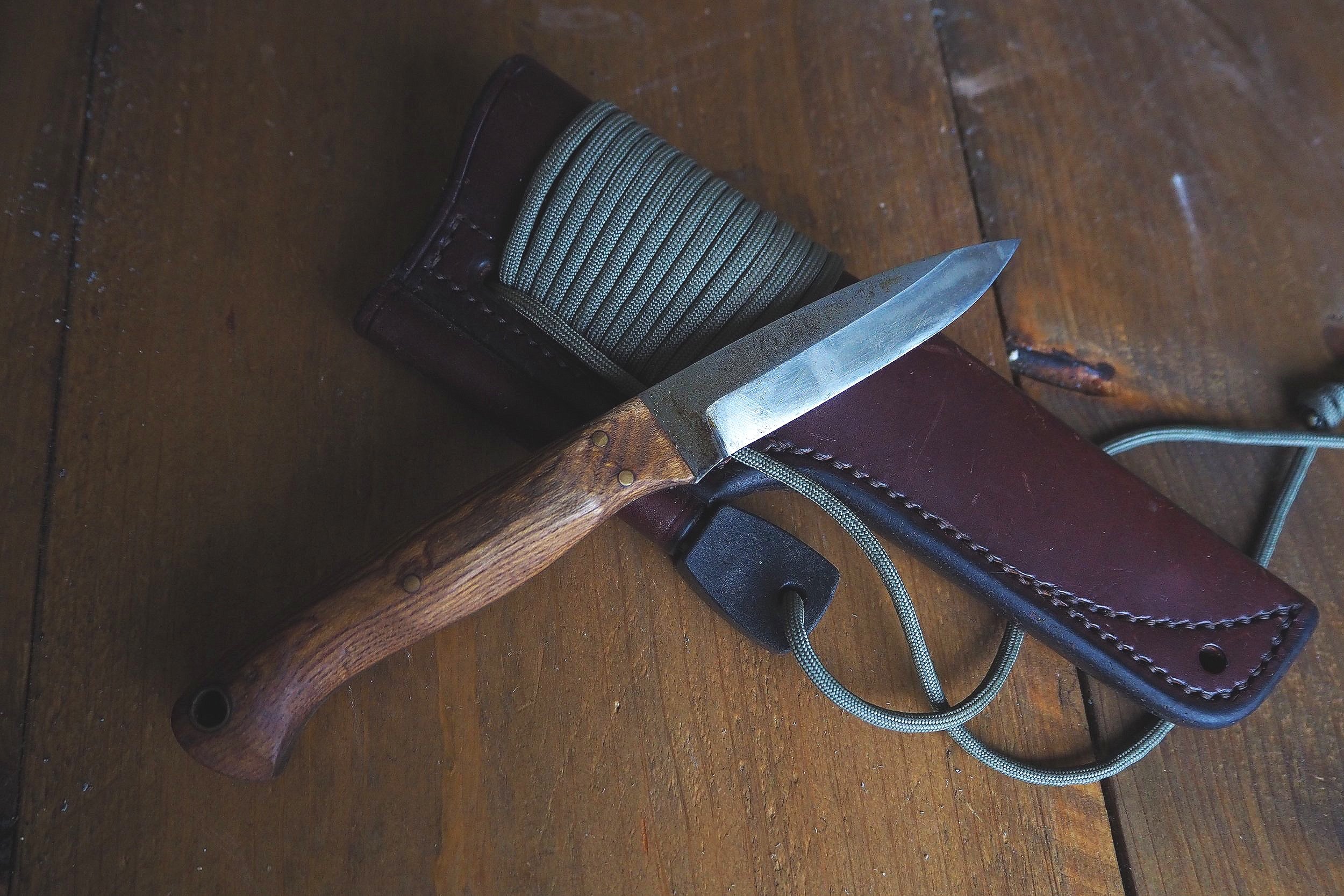
FieldCrafter UK
I got this knife from the Bushcraft UK forum. The maker, going by FieldCrafter UK made two model if I remember, this was the smaller version although it still has a 5mm thick blade.
I wanted to try a thicker blade as I’d not had anything beyond 3mm at this point. The high scandi grind too made for an excellent craft tool but with good splitting power too. I passed my IOL qualifications with this knife.
I bought it as a blade only, so made my own handle out of Wych Elm which I’d never done before. I did ok with this for a first run, but the contours aren’t quite right for my hand and I get hot spots under my index knuckle when I use this knife for a while. I do still very much like the 5mm thickness on a small blade though, it pops wood apart for feathersticks like a wedge!
I never did get a sheath made for this knife, but I found it fitted well enough into this one from Woodlore so that’s where it lives.

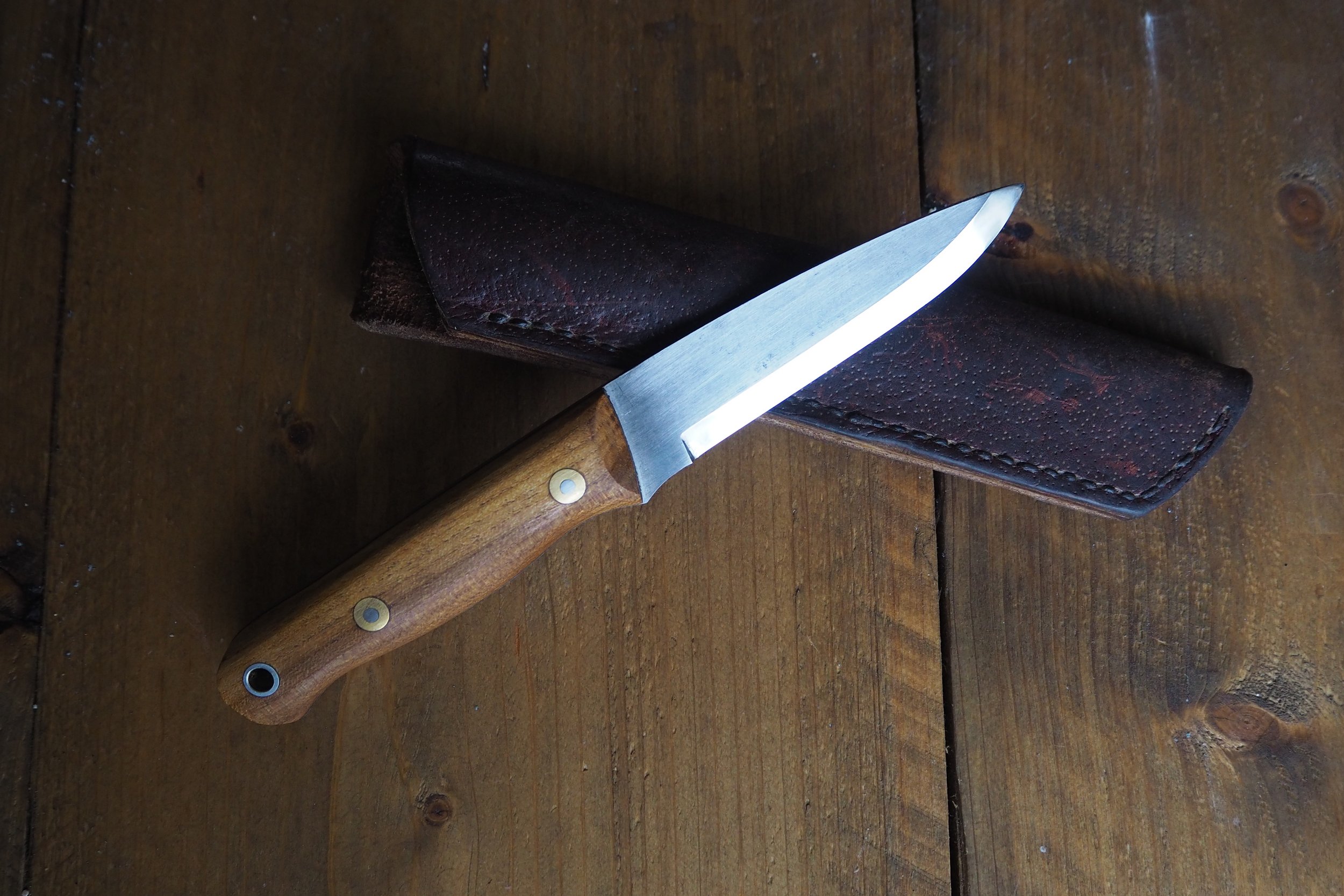
The Woodlore Clone
Here was my first foray into handmade, high value knives. I first saw Bernie Garlands work when a friend of mine bought one of his knives, and I was impressed with the quality. I’d wanted a 4mm Woodlore clone (couldn't afford the real thing) for years and I was happy to spend my money with a local independent maker. I used the for a year, and as my relationship with the tool developed I grew to like the edge geometry but found the handle too large for my hand and the original profile of the spine near the tip wasn’t working for me either.
So, this knife has become something of a Frankinstein’s monster. Some adjustments made to the blade profile by a friend, and a new handle in my favourite wyche elm by another knife maker, and I have a knife that is now perfectly suited to me.
Again in O1, a steel I favour to this day owing to its sharp edge and ease of maintenance in the field.
You’ll see a theme for the rest of the knives here as I now mostly make my own sheaths for them. A combination of preferred style, a desire to make sheaths, and a gift of some beautiful locally tanned leather from my friends at Wood Tools meant I could make several sheaths all to match, though I’ve now run out of leather. I like thick, streamlined sheaths that fit close to the knife and sit high on the belt. No danglers here ta!
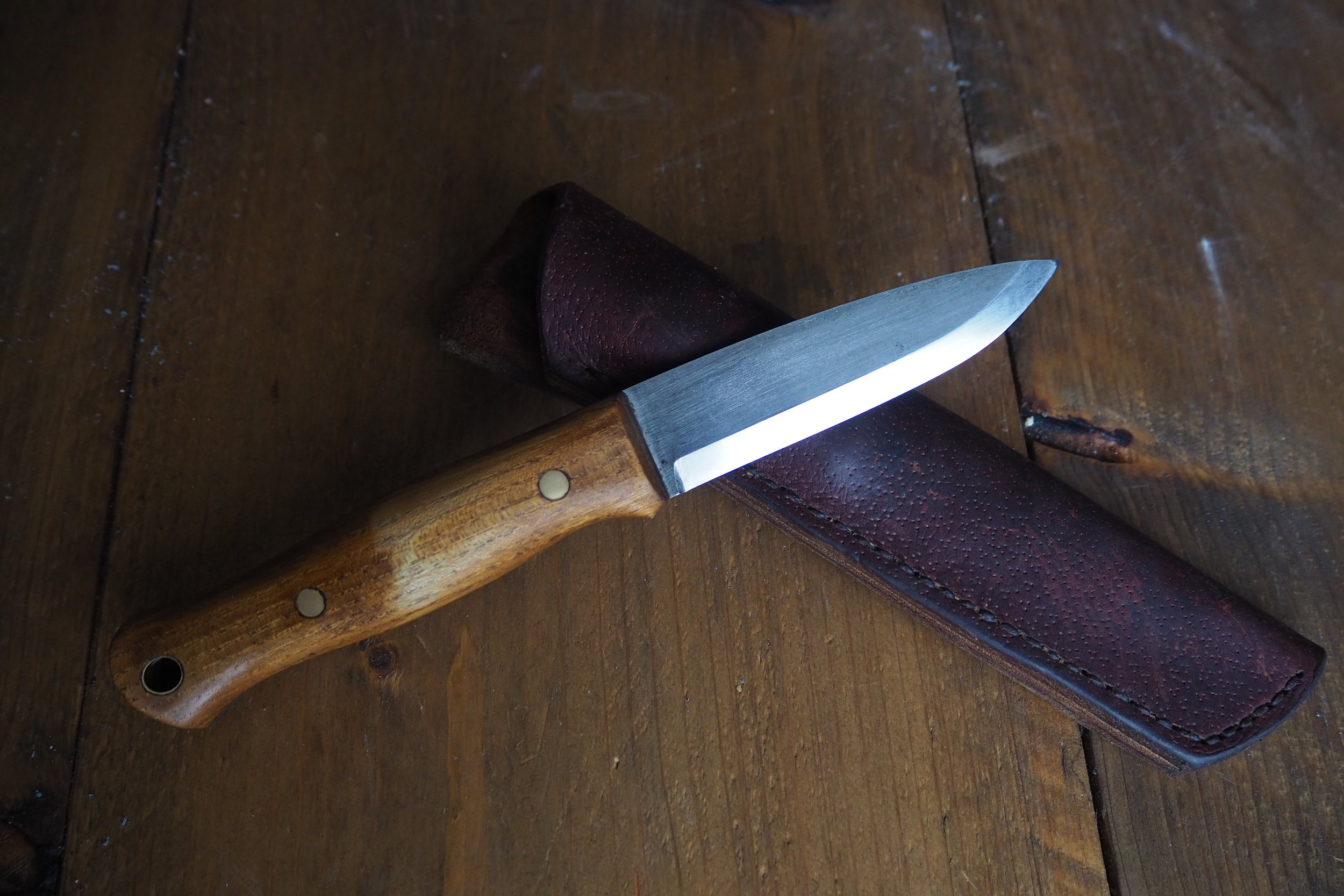
Auroch by Bogdan at Bushcraft-Kit
Owing to my love of the above Bernie Garland knife, prior to the modifications, I found myself wanting a similar blade in 3mm O1 and at the time I was active on the BushcraftUK forum. Here I bumped into a fine gent called Bogdan from Bulgaria who at the time was making knives under the moniker Bushcraft-Kit. His knives looked great, and the craftsmanship with attention to detail seemed good too. So I ordered what he called his Auroch Bushcraft Knife, for £120 which ended up being an absolute bargain!
This is still my go-to knife for general work, course delivery, and trips. The classic coke bottle handle fits me very well, it’s almost perfect. I find 3mm to be an optimal thickness for all crafts and uses including food and game prep, though it sometimes lacks that pop when batoning for feather sticks. 3mm of well treated O1 is certainly strong enough for all applications I use it for, but sometimes I find myself wanting that little extra leverage to open the grain when splitting.
It does seem as though Bogdan has ceased trading, as his website is now expired, but I’d highly recommend him if you do encounter his work.
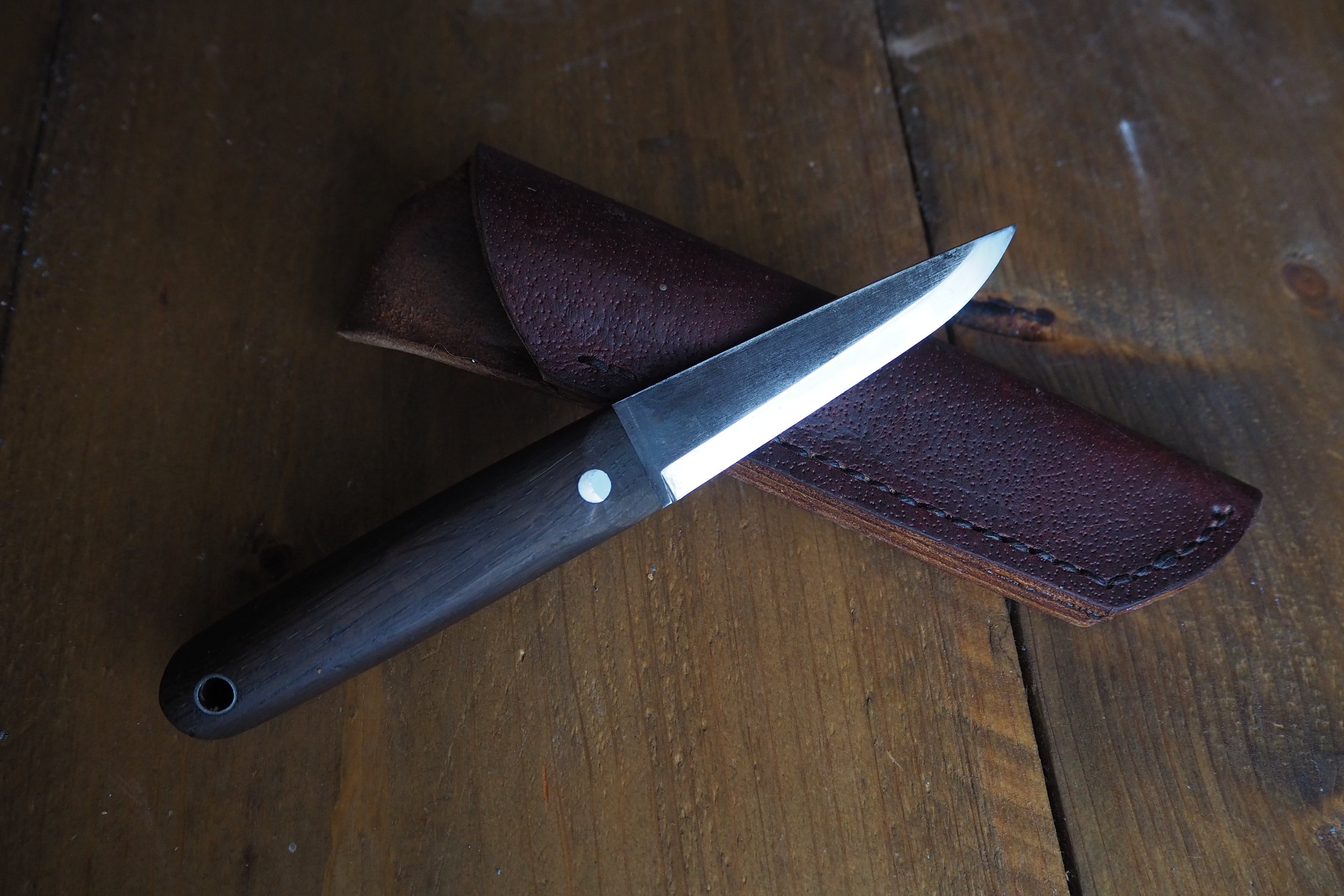
Beaver knife by Bogdan
When I ordered my Auroch from Bogdan, I was blown away by the quality at the price (I’d have spent £250 easy knowing what I do now).
So when he had this knife available for immediate purchase on the forum I snapped it up. I wanted a craft knife in the vein of a slyod knife, and this seemed like an interesting take on the concept. I’ve used it to carve all manner of spoons, spatulas and other crafts for which it excels, but being that bit meatier than say a Mora 106 it also makes for a great light weight option for a belt knife when backpacking.
I believe it’s 2.5mm thick, O1, with bog oak scales.
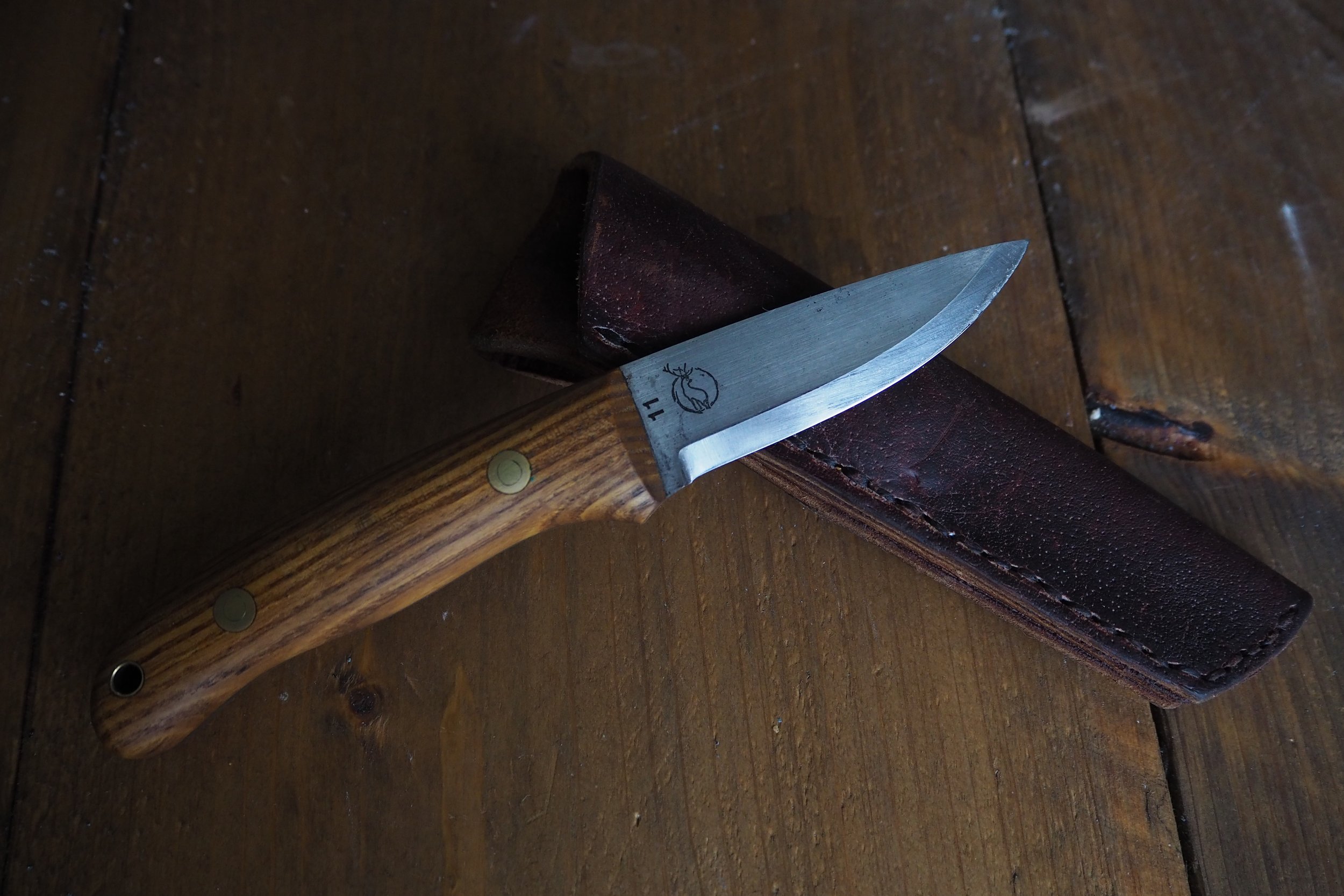
A gift from a friend
I was fortunate enough to land a job at The World of Bushcraft store in Bakewell when I was just a couple of years into running Howl, as a part time sales assistant and in-store customer advisor in all things bushcraft.
The World of Bushcraft is run by the team at Woodland Ways, under the leadership of Jason Ingamells, who hired me to work in the store. Jason was incredibly generous with his knowledge and experience, and was always there to offer me guidance and wisdom as a young newcomer to the bushcraft industry. I owe him, and his team, a lot for helping me find a firm pathway through difficult terrain.
During my time at the store I assisted Jason on a visit to Ben Orford’s workshop during a filming project. I was visible giddy to spend time in that space, to watch and speak with Ben and Lois, and inspired by their approach to work and life.
As I left the store to pursue Howl and other opportunities further, Jason gifted me this very special knife. Number 11 of a series of 15 Jason had commissioned from Ben some years before. 3mm, O1, with an Ash handle. It’s unique design makes for a fantastic all round tool, and is often with me during special trips.
The Nessmuk by Brisa
The knives above I’ve used for years, some more than others, but most have that familiar blade shape of palm width length and a straight edge curving to the tip and a drop tip on the spine. Classic, very practical, and a shape we recommend here at Howl to all who attend our courses.
However, it’s a shape I haven’t really deviated from since getting that first Mora companion. So when we started stocking knives by Casstrom and Brisa on the site I thought to myself “why not try something completely different, and see how I fair? Is the classic shape you’re used to really as good as you think?” So, with the Nessmuk being release by Brisa I bought one for myself to try out.
Based on a drawing my Nessmuk AKA George Washington Sears, Brisa released this pattern with a scan grind in carbon steel. What drew me to it was the longer blade with a continuous curve! no straight section, it’s all belly. I’d not used a knife like this before and I had my doubts that I’d get the kind of precision I was used to.
I discovered I really liked this design, it slices like crazy anything from wood to vegetables. I ended up using this knife for a year as my primary knife, and while I find the shoulder of the tip a little wide for fine crafts my spoon carving, in all other respects it’s actually excellent.
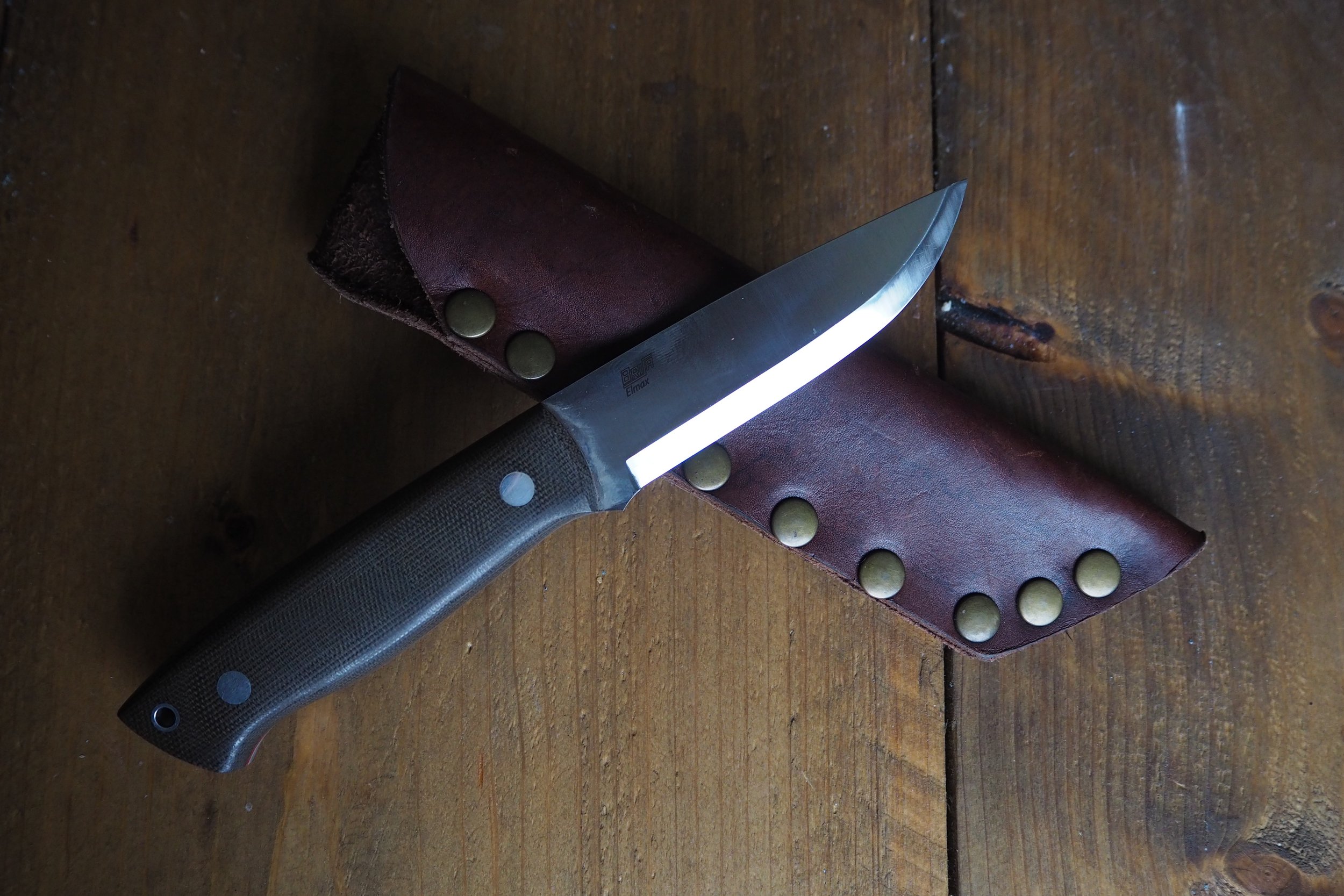
Trapper 95 in Elmax Steel
Brisa enjoyed a short video I made with A Great Alternative for Instagram, and were good enough to send us some knives to play with and make more videos with.
Top of my request list was the Trapper 95 in Elmax, selfishly because I needed a stainless steel knife for canoe trips and this ‘super steel’ got my nerd alert going. The T95 design is a staple in the bushcraft scene, and was a model I’d long admired without getting to use one. So, when they agree’d and sent us this one I was over the moon.
It’s good knife, a nice one to move on to from say a Mora companion, and the Elmax is in a world of it’s own in experience. Very tough, staying sharp for ages… and taking ages to sharpen when it needs it! I like this knife, and do take it on canoe trips where getting very wet for extended periods is more likely, but I find the handle a little narrow for my hand. A solid, clean design though, and that’s why I’m keeping it.
The Garcia All-Weather by Field&Steel
Gifted by the legend that is Steve at Field & Steel, this exclusive colour-way of the Garcia All-Weather is a jewel in my collection.
I’d bought a Jack Rabbit (see below) from Steve during the first lockdown of 2020, and we became firm friends as we discovered we live very close to one another. In discussing knives, Steve suggested a trail this Garcia of his (I nearly bit his hand off!) and if I liked it we could look at stocking the exclusive colours on this website.
In receiving the knife it was somehow smaller than I expected, but quickly proved itself as a capable companion for all manner of bushcraft tasks. I’ve been using this since the summer of 2021 and I’ve often been surprised how I’ve leaned to this over all my other knives in that time. I took it to Affric on canoe expedition as my primary knife, and I was never left wanting. Steve makes a solid knife, with an edge as keen as his eye for detail. It’s size makes it excellent for general crafts from carving notches to spoons, dressing a rabbit to slicing veg. I’ve taken to carrying it as a neck knife, and I find it hangs out with me nicely.
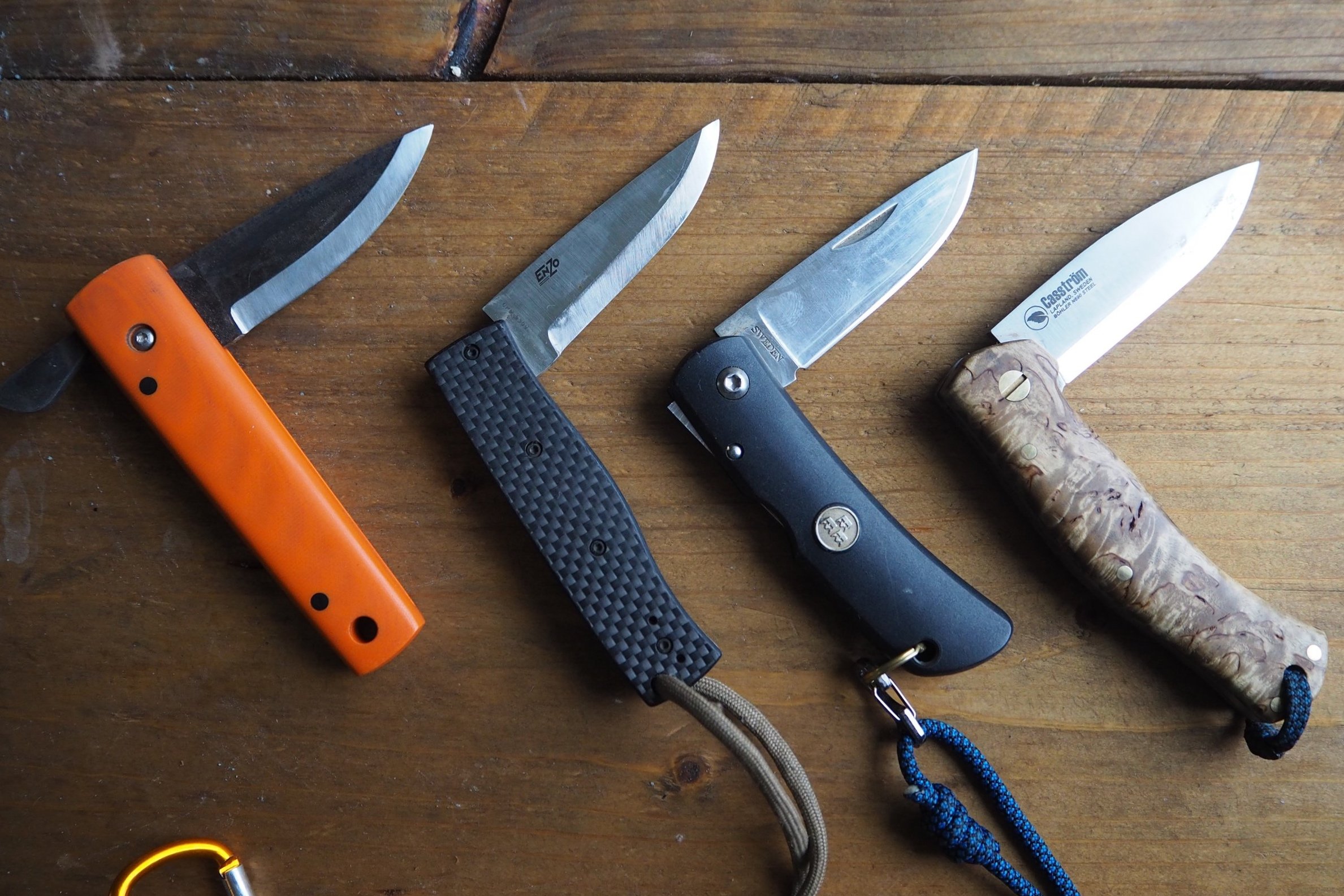
Pocket Knives
For all my love of a good fixed blade, the thing I carry most often is a good folding pocket knife.
Here in the UK your allowed a non-locking, folding knife with a blade 3 inches or smaller as EDC. Outside of that you’ll have to justify your reasons for carrying something. This, combined with a genuine opinion that 90% of the time I can get done what I need with a good pocket knife, means I’m very often only carrying one of the above folders. Only on longer trips, course delivery, or expeds so I feel I need a full fixed blade really.
Above are the Jack Rabbit by Field&Steel, Enzo’s (now Brisa) PK70, the TK4 by Falkniven, and the Lars Falt folder by Casstrom.
Steve’s Jack Rabbit design seems like a mainstay in the folding knife scene these days, it’s hard to imagine he’s only been making them publicly for a couple of years. I bought this one in May 2020, and it’s been often in my pocket since. The rabbit-ear sits in the handle when open, when gripped with the palm it can’t close easily on your fingers and so makes for a great and strong carving knife for its size. The scandi grind is a useful feature as it lends itself to carving with a very familiar feel to my larger belt knives.
The PK70 by Enzo (now Brisa) was the knife that rekindled my love with pocket knives. I’d become used to a higher standard of durability and rigidity with using predominantly fixed blades, something I felt was missing from a Swiss army knife or Opinel (though they do have their place for sure!) and of course, I highly value a scandi grind as you can tell! In all honesty the PK70 was the first pocket knife I’d ever seen with a Scandi grind, and that alone made me buy it. It also has a squared spine, meaning unlike my Swiss army knife I could use it to strike my ferro rod.
I’d found in the cupboard at the World of Bushcraft store when I was rebuilding the display, and bought it that instant. At the time, and little did I know, PK70’s were becoming increasingly hard to find and a short while later Brisa stopped producing them altogether. I would have preferred a contoured micarta handle, which they used to sell as an accessory, but I discovered too late that they stopped manufacture and so mine remains with the carbon fibre handle. This is the reason I don’t carry it often, as the square handle profile becomes uncomfortable after a while of use.
The TK4 is a locking pocket knife, and one that comes on expedition as a lightweight solid backup knife in my pack for those more remote, longer trips.
The Lars Falt Folding Knife by Casstrom was the answer to my predicament with the PK70, it too has a solid scandi ground blade and being non-locking it too is UK legal carry. The handle is longer, and more ergonomic that the Enzo, and as such is now my daily pocket knife for everything I do… I carry it everywhere.
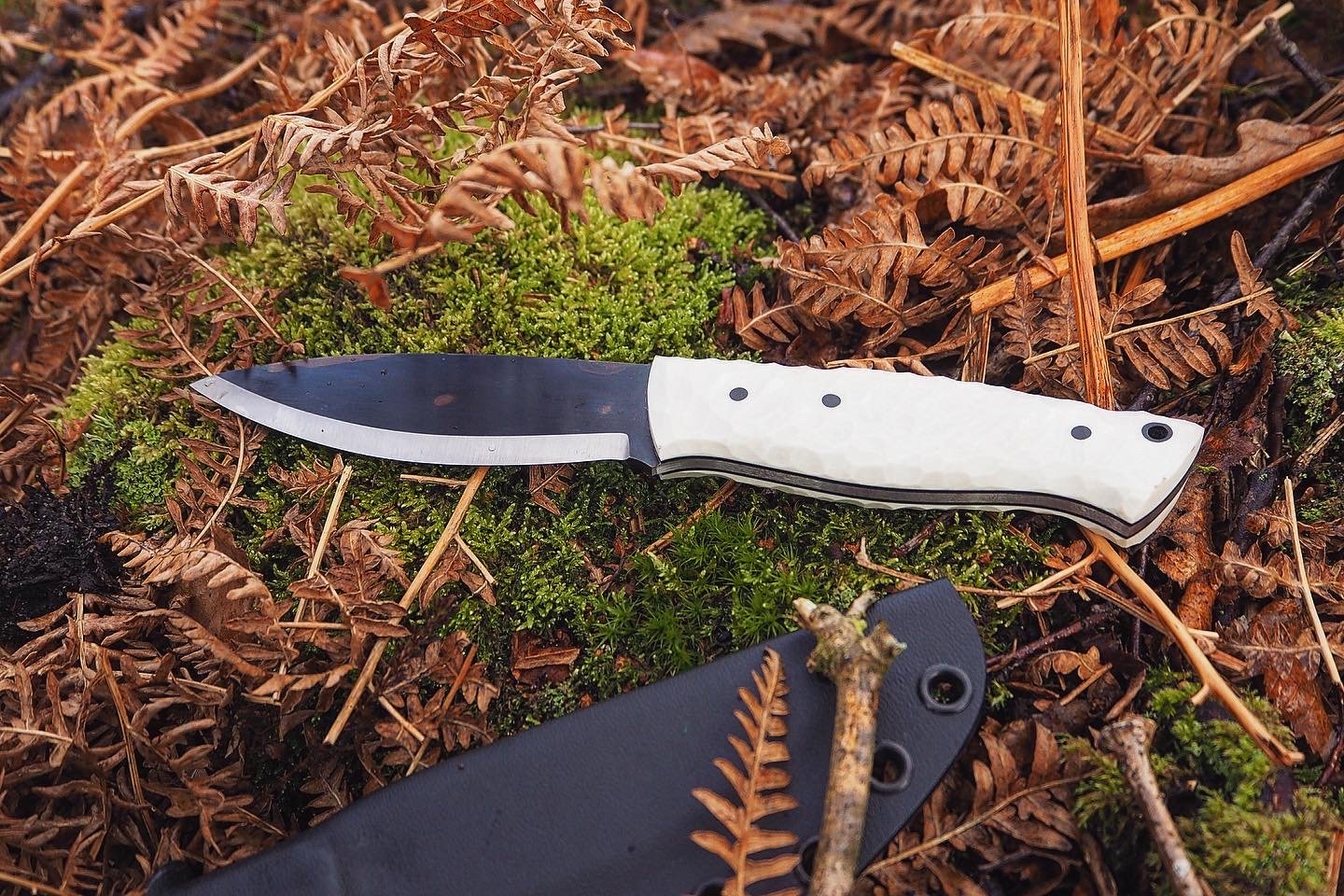
My first knife making attempt
I’ll leave you with my first attempt at making a knife from scratch… a task I undertook with Steve at Field & Steel as he now offers one-to-one knife making workshops.
I can’t speak too much to this one, as I haven’t had it long enough to pass judgment. I designed it myself in combining features from many of the above knives, which I’m sure you can see reflected. I wanted a continuous curve as with the Nessmuk, but with a drop point like my Auroch, and a slender contoured handle taking cues from the Ben Orford, Auroch, Woodlore Clone, Trapper 95, and of course the rock pattern of the Garcia. I’ll let you know how this one goes.
Well, there you go! What was supposed to be a quick photo burst of my knives has ended up taking my 6 hours to write…. all for the love of it though! I hope you enjoyed reading the article, and hopefully it may give you some insight into the choices available.
All the best
JD

